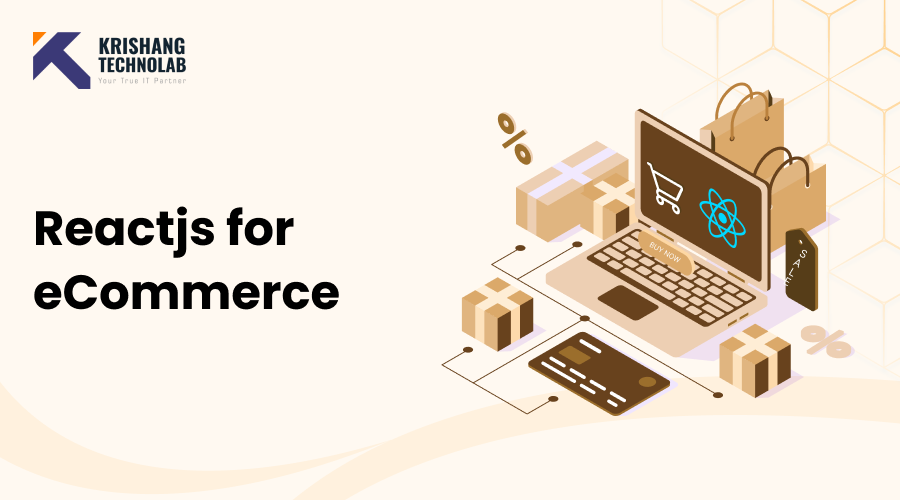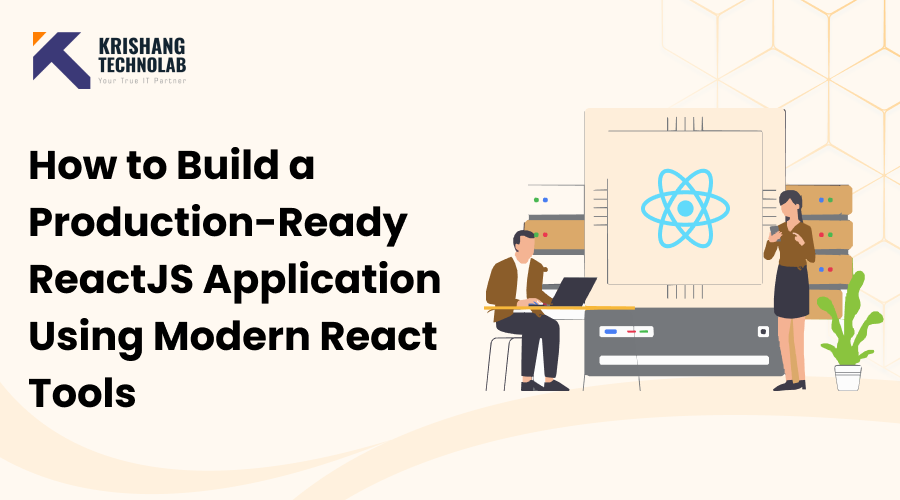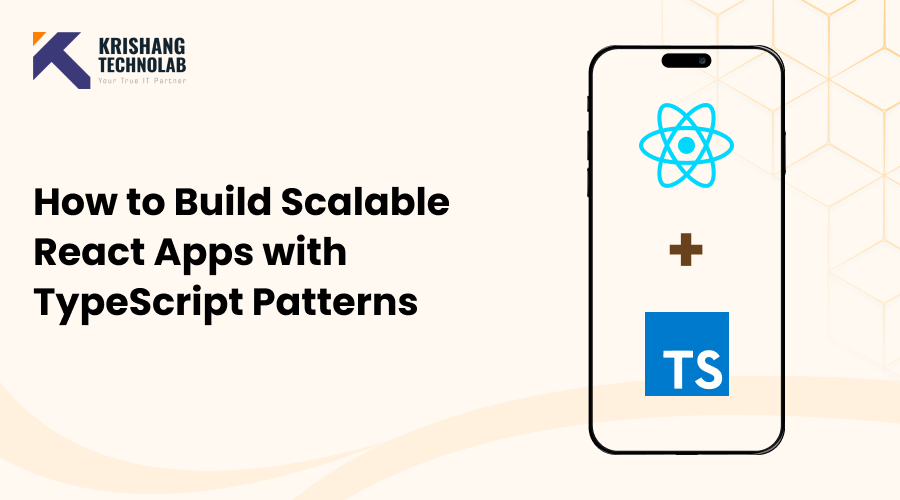Quick Overview: In this blog, we explore why ReactJS for eCommerce is the best choice for building modern online stores. From speed, SEO benefits, and mobile optimization to easy integrations and scalability, React helps startups and growing businesses create smooth shopping experiences. We’ll also cover best practices, common challenges in eCommerce web development, and tips on how to start an online store using ReactJS the right way.
Choosing the right web development technology can be tough for startup owners. With so many options out there, you can easily get lost in the noise. The framework you select for building your eCommerce site determines its smoothness. One framework that continues to stand out is ReactJS. But with all the choices available, you might be asking yourself: why go with ReactJS for eCommerce?
Statistical studies show that from 2024 to 2030, the online retail sector would grow at a CAGR of 18.9 percent. Though many frameworks exist, ReactJS for eCommerce is fast becoming the first choice for developers wishing to build an ecommerce online store. This blog will cover various topics including: Why are businesses focusing on building a react-based ecommerce site? Some architectural best practices as well as how to build ecommerce websites using ReactJS.
Why Choosing the Right Framework for Your eCommerce Website Matters?
Your tech stack isn’t just a backend decision-it’s a business one. The framework you choose to build your eCommerce site sets the stage for everything from performance and scalability to user experience and SEO.
The right framework can be a growth multiplier. It enables:
- Speed & Performance: Faster websites mean higher conversions and better user experience.
- Customizable Frontends: Build a user interface that reflects your brand and meets your users’ needs.
- Mobile Optimization: Modern frameworks support responsive design and fast-loading mobile pages out of the box.
- Future-Proof Architecture: Easier updates, integrations, and the flexibility to adapt as your business evolves.
Choosing a robust framework like ReactJS for eCommerce ensures that your site can keep up with growing customer demands and technological shifts.
Also Read : Shopify vs Shopify Plus: Which One is Best for Your Business?
Benefits of using ReactJS for eCommerce Websites
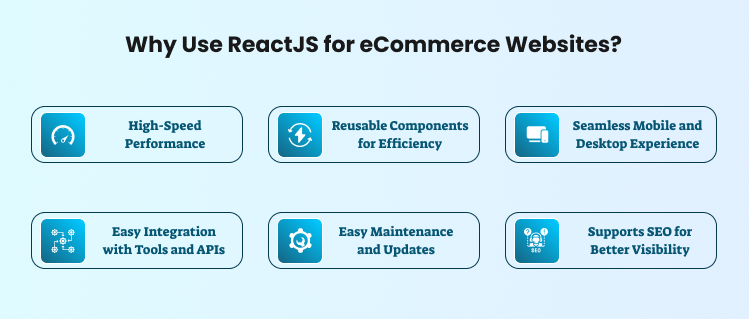
1. High-Speed Performance
React.js improves website performance by using a smart system that updates only parts of the page that change. Instead of reloading the entire site, it refreshes just the content that needs to be updated. For example, when a shopper adds a product to their cart or adjusts a filter, React makes these changes quickly without slowing down the page. This fast performance keeps users engaged and helps reduce bounce rates.
2. Reusable Components for Efficiency
React allows developers to build small, reusable blocks of code called components. Elements like product cards, navigation bars, or “Add to Cart” buttons can be created once and reused across multiple pages. This not only saves development time but also ensures consistency throughout the site. When it’s time to make changes or updates, developers can do it in one place, and it reflects everywhere that component is used. This boosts development speed and ensures consistency across your ReactJS for eCommerce solution. If you hire ReactJS developers, they can efficiently manage these components for faster iterations and updates.
3. Seamless Mobile and Desktop Experience
Today’s shoppers use phones, tablets, and desktops to browse products. React helps create websites that automatically adjust to different screen sizes and devices. This responsive design ensures that your eCommerce site looks great and functions smoothly no matter how someone is accessing it. With mobile shopping growing fast, a flexible site layout is crucial to keep users satisfied.
4. Easy Integration with Tools and APIs
eCommerce websites often need to connect with payment services, shipping platforms, and inventory systems. React makes these connections simpler through easy integration with APIs. Whether it’s pulling in product details from a database or processing orders through Stripe, React helps your website stay connected and functional.
5. Easy Maintenance and Updates
Because of React’s clean structure and component-based approach, making updates or fixing bugs is straightforward. Developers can manage large websites more easily by organizing features into manageable pieces. This helps keep the site running smoothly and allows for fast changes when products, prices, or promotions need to be updated.
6. Supports SEO for Better Visibility
While React is mainly used for building the front-end technologies, it works well with tools like Next.js to make websites search-engine friendly. This means product pages can be better understood by search engines. With server-side rendering, content loads in a way that improves your visibility in search results, bringing more organic traffic to your store.
Features of ReactJS that Perfect for Scalable eCommerce Websites
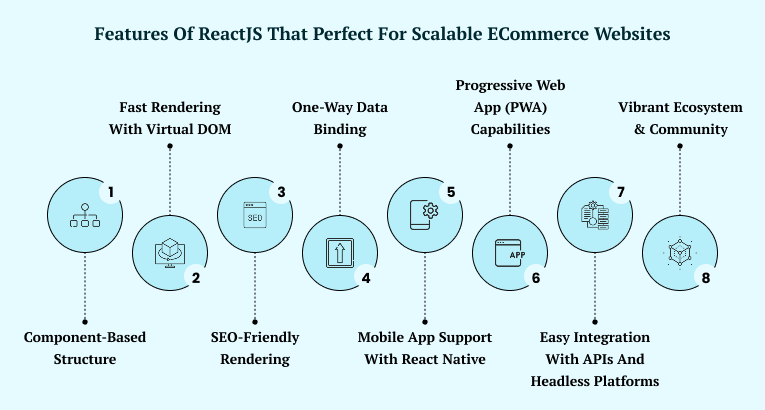
1. Component-Based Structure
React is built around the idea of components-small, self-contained blocks of code that represent parts of the user interface. For an eCommerce website, this means you can create components for things like product listings, shopping carts, or navigation bars and reuse them across different pages. This helps maintain consistency and speeds up development when making changes or adding new features.
2. Fast Rendering with Virtual DOM
React uses something called a Virtual DOM to improve performance. Instead of updating the entire webpage when something changes, React updates only the parts that are affected. This makes websites load faster and feel more responsive, especially on pages with many interactive elements like product filters or checkout forms.
3. SEO-Friendly Rendering
React can be used with tools like Next.js to enable server-side rendering (SSR). This means the page is prepared on the server before being sent to the browser, which helps search engines read and index your content more effectively. For eCommerce businesses, this can lead to better visibility in search results and higher organic traffic to product pages.
4. One-Way Data Binding
React follows a one-way data flow model, meaning that data moves in a single direction through the application. This structure makes it easier to understand how data changes over time and helps developers manage the complexity of dynamic features like updating cart totals or showing product availability in real time.
5. Mobile App Support with React Native
React Native allows developers to use the same principles and components of React to build mobile apps for iOS and Android. This is useful for eCommerce businesses that want to offer both a website and a mobile app without starting from scratch. Reusing logic and design elements between platforms can save time and reduce development costs.
6. Progressive Web App (PWA) Capabilities
React can be used to build Progressive Web Apps, which combine the benefits of websites and mobile apps. With features like offline access, fast load times, and push notifications, PWAs can improve the mobile shopping experience. This is especially helpful for stores with a large audience on mobile devices.
7. Easy Integration with APIs and Headless Platforms
React works well with APIs and is often used with headless commerce platforms like Shopify Hydrogen or Contentful. This setup allows for more flexibility in how your front end is designed and how it interacts with back-end services. It also makes it easier to scale or change parts of your stack without redoing the entire system. A skilled ReactJS development company can help tie together multiple systems to create a cohesive shopping experience.
8. Vibrant Ecosystem & Community
React’s popularity means it comes with a vast ecosystem of tools, libraries, and extensions. Whether you need routing (React Router), state management (Redux, Zustand), form handling (Formik, React Hook Form), or UI libraries (Material UI, Tailwind CSS), there’s a solution for it. Plus, the large developer community ensures plenty of tutorials, forums, and support to help you solve problems quickly.
Common Challenges and Solutions in eCommerce Web Development
Building and maintaining an eCommerce website comes with its own set of challenges. Whether it’s handling high traffic, ensuring security, or offering a smooth user experience, developers face numerous hurdles along the way. Some of the most common challenges in eCommerce web development and offer practical solutions to overcome them.
1. High Traffic and Scalability Issues
Challenge: As your eCommerce website grows in popularity, it may face performance issues when handling high traffic volumes, especially during seasonal sales or promotions. This can lead to slow loading times and frustrated customers.
Solution: To solve this, ensure your website is built with scalability in mind. Use cloud-based solutions and content delivery networks (CDNs) that can handle high traffic. Additionally, optimize your site’s performance by compressing images, minimizing code, and implementing caching techniques.
2. Mobile Responsiveness
Challenge: With a large portion of online shopping done on mobile devices, it’s essential that your eCommerce site functions well on phones and tablets. Poor mobile responsiveness can result in lost sales and a high bounce rate.
Solution: Use responsive design principles to make your site adapt to different screen sizes. Tools like React.js, which automatically adjust layouts based on device type, are essential for building a seamless mobile shopping experience. Prioritize mobile optimization from the start to ensure smooth navigation and fast loading times.
3. Security Concerns
Challenge: Security is a major concern in eCommerce development due to the sensitive nature of user data, including credit card information. A single security breach can damage a company’s reputation and lead to significant financial losses.
Solution: Use SSL encryption to protect customer data during transactions. Implement strong user authentication methods, such as two-factor authentication (2FA), and ensure that your website is PCI-DSS compliant. Regularly update your software and plugins to avoid vulnerabilities and perform security audits to identify and fix potential issues.
4. Payment Gateway Integration
Challenge: Payment processing is a critical part of any eCommerce website, and integrating secure, efficient, and user-friendly payment gateways can be complex. Compatibility issues between various payment methods may also arise.
Solution: Choose reliable payment gateways, such as Stripe or PayPal, that offer easy integration with your platform. Ensure the gateway supports multiple payment methods to accommodate global customers. It’s also essential to test payment functionality across different devices and browsers to guarantee a seamless checkout experience.
5. User Experience (UX) and Design
Challenge: A poorly designed user interface can make it difficult for customers to navigate your site, increasing bounce rates and lowering conversion rates. Ensuring a positive UX is key to keeping users engaged and turning them into paying customers.
Solution: Focus on creating a clean, easy-to-navigate website with a clear product layout and intuitive filters. Incorporate a simple, yet effective, checkout process. Test the design with real users to get feedback and optimize the experience continuously.
6. SEO and Visibility
Challenge: Even the best eCommerce websites can struggle to attract customers if they aren’t optimize for search engines. Without proper SEO, your site may not rank well in search results, limiting organic traffic and sales.
Solution: Optimize your eCommerce site for SEO by focusing on keyword-rich product descriptions, high-quality images with proper alt text, and fast loading speeds. Use server-side rendering to make it easier for search engines to crawl and index your content.
7. Inventory and Order Management
Challenge: Managing inventory and ensuring real-time synchronization between stock levels and product availability is a key challenge for eCommerce sites, especially those with large catalogs.
Solution: Use an integrate inventory management system that automatically updates stock levels when products are purchase. This can reduce human error and keep customers from purchasing out-of-stock items. You can also integrate real-time tracking for better customer satisfaction.
Is ReactJS Right for Your eCommerce Business?
If you’re planning to upgrade your website or start a new online store, React could be the smart choice. It helps you deliver a faster, more enjoyable shopping experience across all devices-and gives your business the flexibility to grow.
More brands are making the switch because they want a reliable, future-ready platform. If you’re looking to create a high-performing eCommerce site, React is worth a serious look.
Conclusion
The popularity of ReactJS for eCommerce is not just a trend—it’s a response to real business needs. Its component-based structure, blazing-fast rendering, and compatibility with tools like Next.js and React Native make it a top-tier solution for modern online stores.
By choosing ReactJS, you’re not only investing in speed and performance but also in future-readiness. As more tech-savvy brands make the switch, one thing becomes clear: if you want an eCommerce platform that scales and delivers—ReactJS for eCommerce is the way forward.
Transform Your eCommerce Business with ReactJS – Partner with Krishang Technolab
Looking for a professional ReactJS development company for your ecommerce business? Krishang Technolab is here to assist! With our extensive ecommerce technology experience, we create safe, scalable, and high-performance ecommerce website that are suited to your specific requirements. Whether you want flawless API connections, a user-friendly interface, or a sturdy architecture, our expert ReactJS developers will provide a smooth and efficient experience. Partner with us to make your fintech concept a reality!
